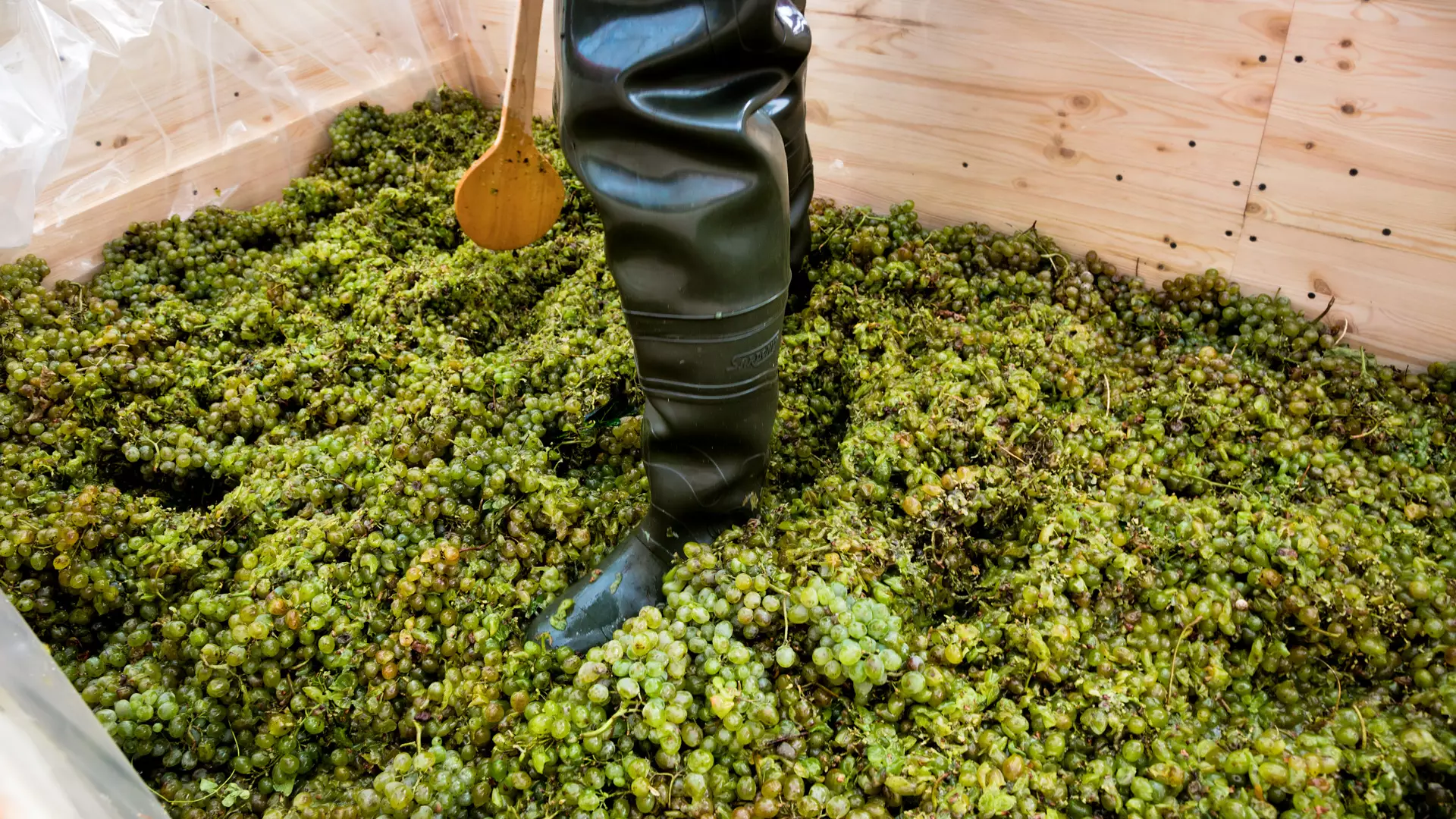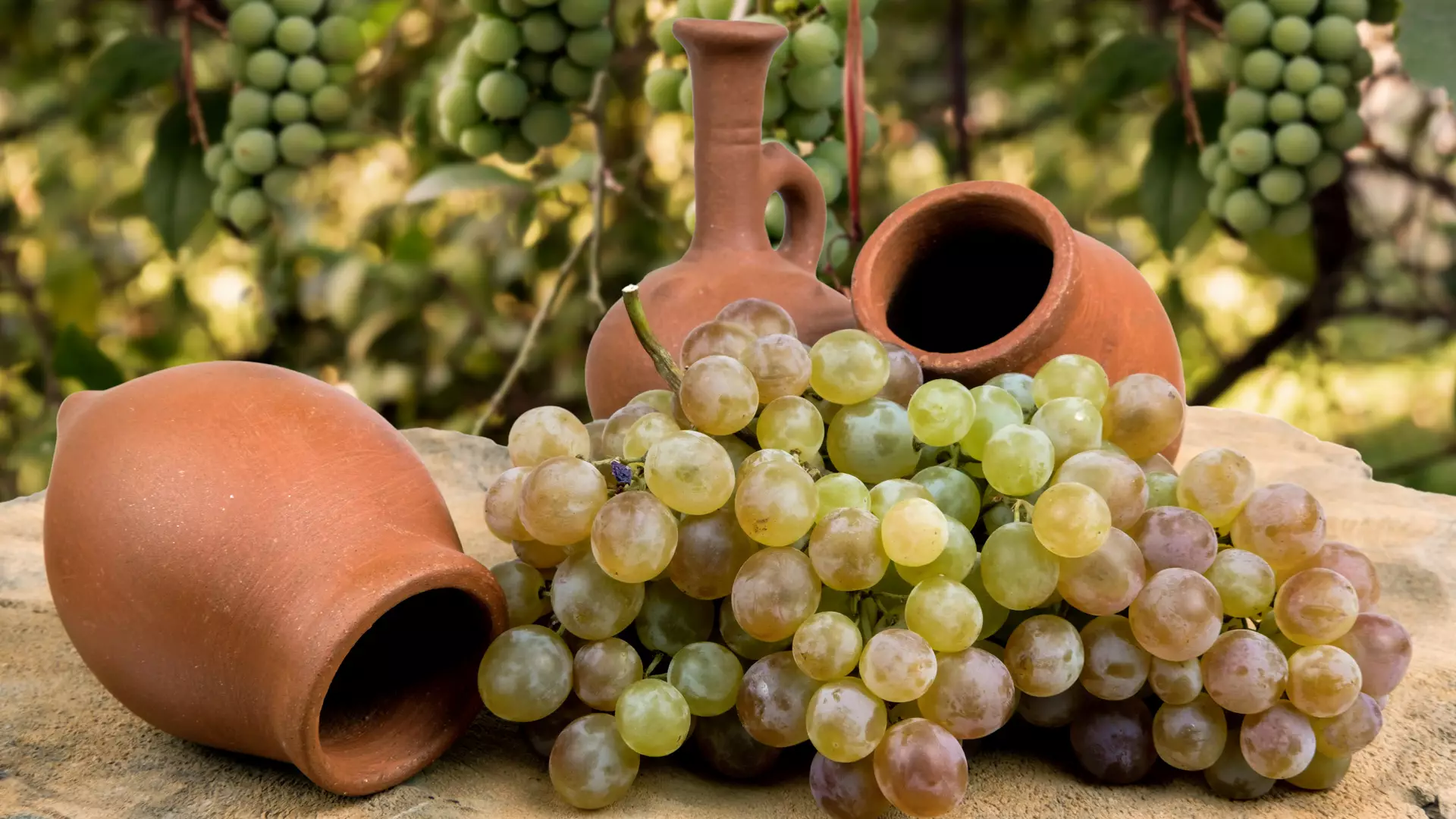Winepress, Pitcher and Horn – Satsnakheli, Qvevri and Kantsi
The Qvevri is functionally the more important and we can say with some certainty that it came first. Georgians were making wine in Qvevri 8,000 years ago. We can assume that the Satsnakheli was invented later by ancient winemakers, to simplify the process of pressing grapes. After the pressing and wine-making processes are concluded, the horn (Kantsi) enters the picture, where the magnificent wine is drunk from.
The Qvevri
The Qvevri is an oval, clay vessel with a cone-framed bottom, which is used for storing grape juice and is produced in different sizes.
The Qvevri has a narrow neck and a rounded top, which allows it to be sealed well. It is made of special clay and ancient technology is still used to finish it off in the desired shape and condition, ready to take the grape juice. The Qvevri is buried in the ground as part of this historic process. Superior to the barrel, this technology allows the wine to be fermented at a constant temperature and minimizes any climatic influence.

The Qvevri has been officially granted the status of an intangible cultural heritage monument, while the Qvevri wine-making method has been UNESCO-listed since 2013.
The Qvevri’s discovery also proved that Georgia is the homeland of wine – 50 km from Tbilisi, in the ancient villages of Gadachrili Gora and Shulavris Gora, archeologists discovered this and other clay vessels with traces of wine. According to some studies, Qvevri decorated with grape ornaments are as old as 8,000 years.
In modern Georgia, the Qvevri is everywhere. It is ubiquitous at family wineries and large wine cellars. Furthermore, today winemakers from Europe and the USA take Qvevri to their countries and use it to make wine with ancient Georgian technology.
Satsnakheli

The Satsnakheli is a vessel used for pressing grapes and wine-making and has been part of the traditional Georgian wine-making process for millennia.
Satsnakhelebi (plural) are still used in family wineries and are mostly made of wood. To make these, a huge tree is cut down, and only the right piece of wood is chosen. Then, like the Native Americans used to make canoes, they carve the wood until the desired capacity is reached.
After that, one side of the Satsnakheli is sealed and on the other side, a special hole is made to release the grape juice. The upper part of the Satsnakheli is wide enough for a man to stand in and press the grapes with his feet. This process has been a kind of ritual for Georgian winemakers since ancient times, with numerous pieces of folklore, including dances and songs, related to this process.
In addition to wood, Georgians used to make Satsnakhelebi from stone as well, and sometimes they carved into the rocks. The oldest Satsnakheli discovered in Georgia is related to the Hellenic era. This winepress is well preserved and located 50 km from Tbilisi, in the ancient town of Uplistsikhe, which itself is cut into a rockface. This Satsnakheli was carved in the 4th millennium BC. Hence, we can say assuredly that it is 2,000 years younger than the Qvevri.
The stone winepresses made on the territory of Imereti were approximately in the same form as the wooden ones. Indeed, huge boulders were diligently cut until the desired shape was achieved. The length of such winepresses ranged from 2 to 4 meters, with the height going from 40 to 60 centimeters. It takes 2-3 months of hard work to produce such a Satsnakheli. Due to its purpose and importance, natives of Imereti call it “treasure.”
Traditionally, a family who owned the largest and most distinguished Satsnakheli was considered the most powerful and others showed it and them more respect. In western Georgia, a New Year's ritual was held in wineries next to the Satsnakheli where people prayed for fertility and prosperity.
Kantsi

After the grapes were pressed and then the grape juice was stored in the Qvevri, the eventual wine would be poured using an Orshimoti and brought to the table. “Kantsi!” the tamada (toastmaster) would demand, and then praise God with the first toast.
Yes, the Kantsi was used widely in ancient times, although now it has a more decorative function.
The Kantsi is made of animal horn, and very solid but light. Georgians used the horns of ibex, bull, buffalo, cow, wild goat, and gazelle to make Kantsebi. There are two dominant types of Kantsi in Georgia, with some used for drinking wine and the other for chacha.
In general, horns were and are either articraft or handicraft. The second are handmade, unlike the articraft type which is more artistic. More luxurious horns are strewn with gold and silver, with niello or damask technology.
The Kantsi has traditionally been used in Georgia mostly at weddings and other festive rituals and used to be an essential accessory for the tamada.
Tamada’s Kantsi

Among the richest archeological materials found in Vani was a bronze figure of a man, sitting on a chair like a tamada, holding a Kantsi in his hand. The statue is dated 5th century BC. Taking that into consideration, we can surely say that the traditional Georgian feast dates back at least 7,000 years. Traditionally, the Georgian feast (supra) is led by a tamada, who should be widely admired and usually among the older and wiser members of the group. A tamada has to be a good orator – this is obligatory. It is also desirable that they sing well. A tamada praises God in their first toast and then blesses the reason for the gathering, which might be a wedding, birthday, baptism, or any other celebration. The supra’s speed and style is then steered by the skilled tamada.
Now that you know almost everything you need to know about Georgian wine and Supras, the next sensible step would be to visit Georgia and experience it for yourself!
Cookie Policy
